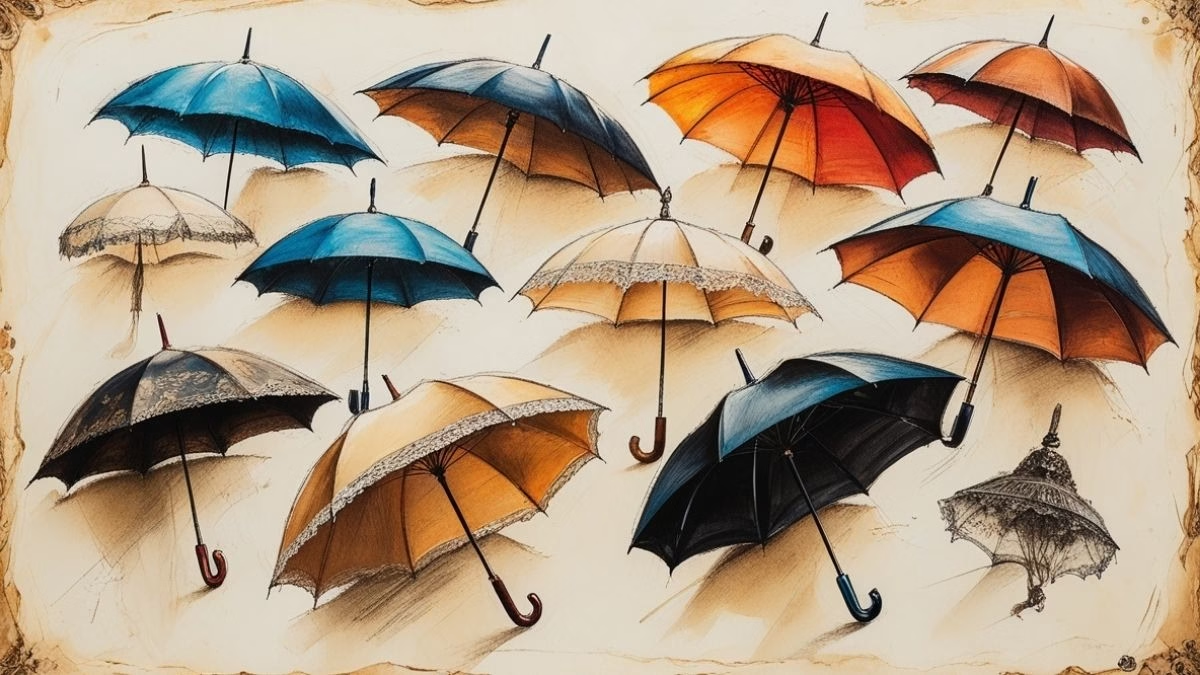Audio Episode
[ppp_patron_only level=5]
[/ppp_patron_only]
Introduction
Have you ever stopped to think about the humble umbrella? It’s such an everyday object, we barely give it a second thought. But tucked away in its folds is a fascinating and surprising story that spans over 4,000 years of human history, connecting ancient emperors, fashionable ladies, and brave social rebels.
This quiz is your chance to uncover that hidden history. It’s not a test, but a journey of discovery. We’ll travel back in time to see how this simple device was once a powerful symbol of status and divinity, how it caused a stir on the streets of London, and how it evolved into the practical tool we all use today.
By taking this quiz, you will:
- Uncover Surprising Facts: Learn the amazing and unexpected origins of this common object.
- Travel Through Time: Journey from ancient Egypt and China to 18th-century London and beyond.
- Learn in a Fun, Engaging Way: Pique your curiosity with questions designed to make you say, “I never knew that!”
- Appreciate the Everyday: You’ll never look at an umbrella the same way again!
Ready to unfold the amazing history of the umbrella? Let’s dive in.
Learning Quiz
This is a learning quiz from English Plus Podcast, in which, you will be able to learn from your mistakes as much as you will learn from the answers you get right because we have added feedback for every single option in the quiz, and to help you choose the right answer if you’re not sure, there are also hints for every single option for every question. So, there’s learning all around this quiz, you can hardly call it quiz anymore! It’s a learning quiz from English Plus Podcast.
[ppp_patron_only level=5]
[/ppp_patron_only]
Quiz Takeaways
Hello and welcome! Let’s talk about something you’ve probably seen or used a thousand times without giving it a second thought: the umbrella. It’s such a simple, everyday object. But what if I told you that its history is filled with emperors, social revolutions, high fashion, and bitter rivalries? The story of the umbrella is the story of how a sacred symbol of power became a practical tool for everyone.
Our journey begins over 4,000 years ago, under the hot sun of the ancient world. In civilizations like Egypt, Assyria, and especially China, the first umbrellas appeared. But they had nothing to do with rain. Their purpose, as the quiz revealed, was to protect from the sun. The word itself, from the Latin “umbra” for “shadow,” tells us its original job was to be a portable “little shadow.”
But this wasn’t a shadow for just anyone. In the ancient world, being shielded from the sun was a sign that you didn’t have to work in the fields. It was a symbol of nobility, power, and even divinity. In Egyptian art, we see servants holding large sunshades made of palm leaves or feathers over their rulers. In China, the umbrella became an intricate symbol of the Emperor’s authority. These were magnificent creations of silk, with multiple tiers or layers—the more layers, the higher your rank. The emperor’s umbrella was the most elaborate of all, a mobile canopy signifying his place as the center of the universe. So, for thousands of years, the umbrella wasn’t a personal item; it was a piece of royal regalia, carried by a servant for a ruler.
As ideas traveled, the umbrella, or parasol as we call the sun-only version, made its way to ancient Greece and Rome. Here, its story takes a turn. It lost some of its sacred, kingly status and became a high-fashion accessory. But, as we learned in the quiz, it was almost exclusively for women. Wealthy Greek and Roman women used ornate parasols to protect their fair complexions from the Mediterranean sun. For a man to use one was considered shocking and effeminate. This idea—that the umbrella was a woman’s accessory—would stick around in Europe for over a thousand years.
Let’s fast-forward to 18th-century Europe, particularly London. The parasol was still a fashionable lady’s item. But London is a famously rainy city, and a few forward-thinkers started to see the potential of the umbrella for rain. The problem? It was still seen as unmanly. Men were expected to wear a hat, brave the rain, and if they got soaked, dash into a horse-drawn carriage for a fee.
This is where our hero, Jonas Hanway, enters the story. Around 1750, Hanway, a traveler who had seen umbrellas used by men in other parts of the world, became the first Englishman to stubbornly and publicly carry an umbrella in the rainy streets of London. And the reaction was not positive. As we discovered, he was mocked, ridiculed, and seen as an eccentric. Carriage drivers, who saw the umbrella as a threat to their rainy-day business, were his biggest enemies. They would shout at him and even try to splash him with mud. For thirty years, Hanway endured this public scorn. But slowly, logically, other men started to see the sense in it. Why get soaked when you don’t have to? Hanway’s persistence paid off, and he normalized the umbrella as a tool for the English gentleman.
But even with its newfound social acceptance, the umbrella had a design problem. It was heavy, clumsy, and often made with whalebone ribs and an oily, waxy canvas that was smelly and slow to dry. The Industrial Revolution would change that. In 1852, a man named Samuel Fox, inspired by the light, strong, and flexible steel stays used in women’s corsets, invented the steel-ribbed umbrella frame. This was a game-changer. His “Paragon” frame made umbrellas lighter, more durable, and cheap enough to be mass-produced. The umbrella was no longer a luxury item; it was for everyone. This led to the rise of specialty shops, like the famous “James Smith & Sons,” which opened in London in 1830 and is still there today.
The final chapter in our story is the invention of the umbrella we know and love—and lose—today: the compact, collapsible model. For all its improvements, the standard umbrella was still a long, awkward stick. In 1928, a German inventor named Hans Haupt created the first working telescopic pocket umbrella, which he called the “Knirps” or “little fellow.” This design was refined over the years, and in the 1960s, a fully-functioning, push-button folding umbrella was patented, solidifying its place in our briefcases and bags.
From its origins as a sacred sunshade for an emperor in China, to a fashion statement for a Roman lady, to the source of ridicule for a brave man in London, the umbrella has had a remarkable journey. It has been a symbol of power, an engine of social change, and a canvas for technological innovation—from the Wright Brothers who sold them in their bike shop to the Hong Kong protesters who used them as shields in the Umbrella Movement.
So, the next time you open your brolly on a rainy day, take a moment to appreciate the thousands of years of history you’re holding in your hand. It’s more than just a way to stay dry; it’s a testament to human ingenuity and our long, shared story of seeking shelter, status, and a little bit of personal space in a crowded world.










0 Comments